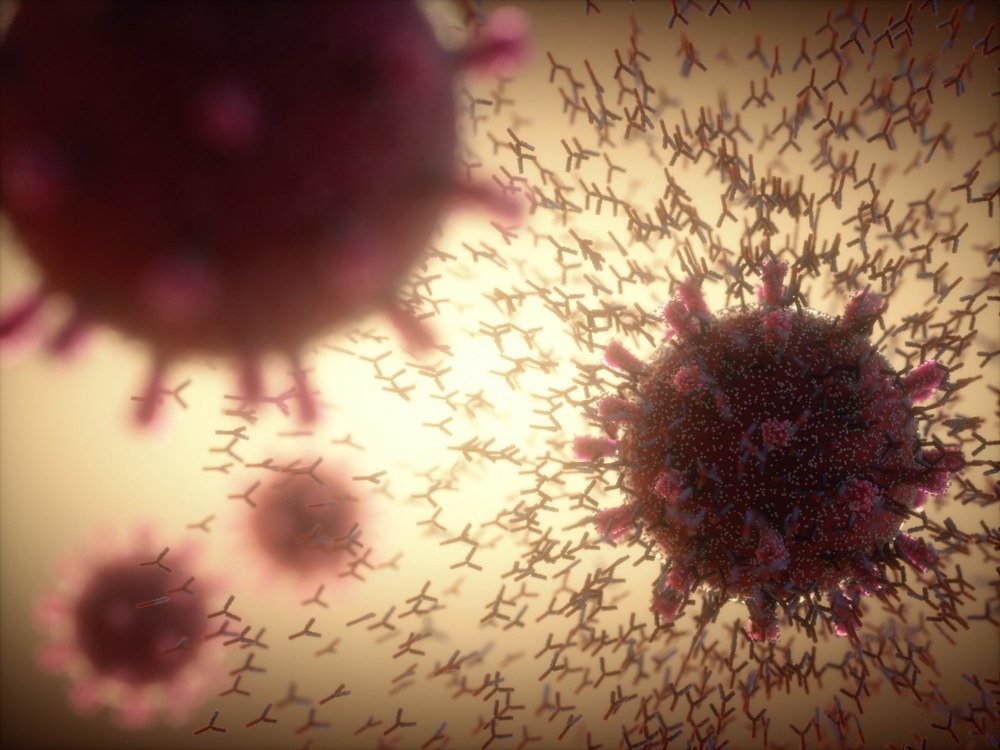In a recent study published in Immunity, researchers isolated SARS-CoV-2 spike (S) protein-targeted mAbs (monoclonal antibodies) from convalescent healthcare workers (HCWs), emphasizing the IGHV1-69 (immunoglobulin heavy variable 1-69) gene, the gene with the greatest structural and allelic variation.

Background
The human immunoglobulin (Ig) heavy chain (HC) locus has remarkable polymorphisms with a high degree of structural and allelic variation. The personal germline IGH genotypes might alter responses to vaccination and infection. However, data on allele-specific responses are limited, and further research is required to deepen understanding of inter-individual differences in Ab responses.
About the study
In the present study, researchers performed immunoglobulin genotyping of prior severe acute respiratory syndrome coronavirus 2 (SARS-CoV-2)-infected HCWs to detect structural and allelic variations, especially those that affect IGHV 1-69.
An individual with numerous anti-S memory B lymphocytes and elevated IGHV composition was chosen, from whom 29 anti-SARS-CoV-2 mAbs were isolated. The effects of IGHV use were evaluated by reverting a robust IGHV1-69*20 utilizing neutralizing Ab, CAB-I47, to sequences of the IGHV1-69*20 allele and five other alleles of IGHV1-69. High-resolution cryo-electron microscopy (cryo-EM) was performed to assess molecular Ab-SARS-CoV-2 S receptor-binding domain (RBD) interactions.
The study cohort comprised 14 HCWs (SP01 to SP14), who tested SARS-CoV-2-positive by reverse transcription-polymerase chain reaction (RT-PCR) analysis in May 2020 to assess memory B lymphocyte responses and anti-S Ab evolution. Sera and peripheral blood mononuclear cells (PBMCs) were obtained 7.0 months post-SARS-CoV-2 infection. The study participants elicited anti-S IgG titers and neutralized SARS-CoV-2. To assess participant IGHVV genotypes, IgM libraries were expressed, bulk sequenced, and analyzed.
Further, haplotype analysis was performed to identify alleles present on the chromosomes of the participants. SP14 (who had 3.0 IGHV1-69 gene alleles IGHV1-69*01, 02, *20) was selected for further analysis, for whom the lambda and kappa light chain V alleles, IGLV and IGKV, were determined. Anti-S IgG+ memory B lymphocytes were sorted for Ab sequence analysis.
Further, PMBC ribonucleic acid (RNA) sequencing was performed, and Ab V(D)J sites from the sorted cells were amplified by RT-PCR. IGHV1-69 allele sequence alignment was assessed, and CAB-147 mAb (which used IGHV1-69*20) was chosen to assess the role of IGHV1-69 allele variations.
Furthermore, the V gene site was reverted to the IGHV1-69*20 configuration to assess the contribution of somatic hypermutations (SHMs) towards CAB-I47 neutralization ability. Structural analysis was performed, and the binding affinities for CAB-I47, CAB-I47gL*20, CAB-I47gL*04, and CAB-I47 F55L Fabs (fragment-antigen binding) were assessed by surface plasmon resonance (SPR) analysis.
Genetics & Genomics eBook

Germline-reverted (gL) HCs were co-expressed with mature LCs of CAB-N86 and CAB-M77, and their neutralization potencies were determined. Further, HDX-MS (hydrogen-deuterium exchange mass spectrometry) was performed to assess CAB-M77 and CAB-I47 target specificities.
Results
CAB-I47 Ab depended critically on allele use, and SARS-CoV-2 neutralization was maintained when reverting the variable (V) site to the IGHV1-69*20 allele but lost when reverting to other IGHV1-69 alleles. Structural analysis findings showed that the F55 and R50 germline-encoded genetic polymorphisms in IGHV1-69 were essential for high-binding affinity S RBD-Ab interactions. CAB-I12, CAB-M77, CAB-I47, CAB-J39, and CAB-N86 mAbs potently neutralized SARS-CoV-2 using the IGHV1-69*20 allele, found to be critical for Ab function.
Six alleles were detected in the participants, which were IGHV1-69*01, *02, *04, *06, *09, and *20. Participants SP-01, -02, -06, -08, and -11 showed IGHJ heterozygosity (IGHJ6*02, -03), SP14 showed IGHD2-21 heterozygosity (IGHD2-21*01,*02), and SP-04, 05 showed IGHD3-10 heterozygosity. Haplotype analysis findings confirmed high structural and allelic variations in IGHV1-69. In the study, heavy chain sequences (n=177) and paired heavy chain-light chain sequences (n=146) were identified.
A highly polyclonal anti-S response was observed, with 171 distinct clones from 177 analyzed HC sequences. Many mAbs utilized IGHV3-53 and comprised small HCDR3s (HC complementarity-determining region 3), indicative of class 1 type anti-SARS-CoV-2 Abs, and CAB-52, a highly potent SARS-CoV-2-neutralizing mAb, utilized IGHV3-30-3*01. Most of the potent SARS-CoV-2-neutralizing mAbs utilized the IGHV1-69*02, *20 alleles.
The average SHMs for neutralizing mAbs were 10% and 6.0%, and 10% in the amino acid sequence and the nucleotide (nt) sequence, respectively, and the J gene lacked SHMs. SP14 elicited IGHV1-69 using potent neutralizing mAbs. The ancestral SARS-CoV-2 strain neutralization potential of CAB-I47gL*20 (variable gene gL CAB-I47 mAb version) was 6.0-fold lower than other Abs.
The gL allele-swapped Abs lost SARS-CoV-2-neutralizing ability, except the CAB-I47gL*04 mAb. CAB-I47 F55L neutralization was lower by >10-fold in comparison to the CAB-I47 mAb. The binding affinity was considerably lesser for the CAB-I47 mAb fragment-antigen binding region than for CAB-I47gL*20. CAB-I47 F55L fragment-antigen binding region showed comparable on-rates as CAB-I47, but rapid off-rates and CAB-I47gL*04 fragment antigen-binding region showed very low S RBD-binding affinity.
From the CoV-Ab database, the team identified neutralizing IGHV1-69-using Abs, BD56- 031, BD57-005, REGN1097740, XGv-23239, C1210, C121142, and C14646P3S41, that used IGHV1-69*20. CAB-I47 Fab was bound to the upper RBD region and belonged to class 2 anti-RBD Abs. CAB-I47, CAB-M77 and CAB-N86 were sensitive to the Zeta (the ancestral D614G strain comprising E484K) mutation. CAB-I47 Fab blocked angiotensin-converting enzyme 2 (ACE2) binding due to steric conflicts. The light chain was also involved. CV1206, CV118237, and BG1-2438 mAbs used the IGHV1-69*20 allele and were sensitive to the Zeta mutation.
Conclusion
Overall, the study findings showed that single IGH gene polymorphisms could impact the SARS-CoV-2-neutralizing Ab function.
- Pushparaj, P. et al. (2022) "Immunoglobulin germline gene polymorphisms influence the function of SARS-CoV-2 neutralizing antibodies", Immunity. doi: 10.1016/j.immuni.2022.12.005. https://www.sciencedirect.com/science/article/pii/S1074761322006410
Posted in: Medical Science News | Medical Research News | Disease/Infection News
Tags: ACE2, Allele, Amino Acid, Angiotensin, Angiotensin-Converting Enzyme 2, Antibodies, Antigen, B Lymphocyte, binding affinity, Blood, Coronavirus, Coronavirus Disease COVID-19, Electron, Electron Microscopy, Enzyme, Evolution, Gene, Genes, Genetic, Genotyping, Germline, Healthcare, immunity, Immunoglobulin, Locus, Lymphocyte, Mass Spectrometry, Microscopy, Mutation, Nucleotide, Polymerase, Polymerase Chain Reaction, Protein, Receptor, Research, Respiratory, Ribonucleic Acid, RNA, SARS, SARS-CoV-2, Severe Acute Respiratory, Severe Acute Respiratory Syndrome, Spectrometry, Syndrome, Transcription

Written by
Pooja Toshniwal Paharia
Dr. based clinical-radiological diagnosis and management of oral lesions and conditions and associated maxillofacial disorders.
Source: Read Full Article
